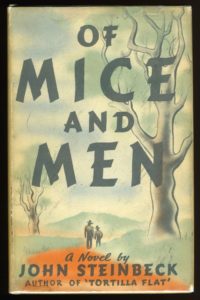One hundred and seventeen years ago this week, in a small rural town in Salinas, California (a region he immortalized time and again in his fiction), John Steinbeck was born. Steinbeck—who was himself no stranger to poverty and hardscrabble living—rose to prominence in 1935 with the publication of his fifth book, Tortilla Flat, and went on to become perhaps the most renowned social novelist in the history of American letters.
His books tended to focus on the downtrodden—migrant agricultural laborers and Dust Bowl drifters struggling to stay afloat during the depression. The most famous of these, The Grapes of Wrath, earned its author the Pulitzer Prize and National Book Award, was made into a celebrated film starring Henry Fonda, and featured heavily in his 1962 Nobel Prize citation.
Below, we take a look back at the very first reviews of what we consider to be Steinbeck’s five most iconic works—from the simple-but-devastating novella Of Mice and Men, to the epic, multigenerational melodrama East of Eden.
*

Tortilla Flat (1935)
Thoughts are slow and deep and golden in the morning.
“Mr. Steinbeck tells a number of first-rate stories in his history of Danny’s house. He has a gift for drollery and for turning Spanish talk and phrases into a gently mocking English. The book is as consistently amusing, we think, as February Hill. But we doubt if life in Tortilla Flat is as insouciant and pleasant and amusing as Mr. Steinbeck has made it seem.”
*

Of Mice and Men (1937)
Maybe ever’body in the whole damn world is scared of each other.
…
“The theme is not, as the title would suggest, that the best laid plans of mice and men gang aft agley. They do in this story as in others. But it is a play on the immemorial theme of what men live by besides bread alone. In sure, raucous, vulgar Americanism, Steinbeck has touched the quick in his little story.”
Keine Kommentare:
Kommentar veröffentlichen